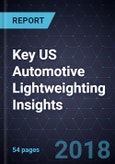American and German OEMs Targeting Increased Use of Magnesium Compared to their Asian Counterparts
The aim of this study is to research and analyze the short-, medium-, and long-term impact of advanced lightweighting materials in the automotive industry, especially with regard to magnesium and aluminum. Readers of this report should be able to understand the trends that these metals are setting in the industry and how their use can be compared to other lightweighting strategies (for example, the use of carbon, glass, and natural fiber reinforced plastics).
Research Highlights
The study only discusses the impact of these materials on passenger vehicles, which are classified as cars and light trucks, during the 2017-2030 period.
Some of the key objectives of this study are:
- To provide key insights into future automotive lightweighting capabilities, especially with regard to magnesium and aluminum applications
- To analyze the reasoning behind key lightweighting strategies as influenced by government fuel efficiency and emissions regulations
- To foster an understanding of the key trends for lightweighting, during 2017-2025, and how OEMs are expected to tap these trends
- To provide information on the opportunities available in the future for lightweighting
- To provide future recommendations that could help OEMs define their lightweighting strategies
The study also discusses the impact that the previous Corporate Average Fuel Economy (CAFE) standards, and regulations set by the previous US government back in 2012, had on automotive OEMs and suppliers in the US. However, with policies of the new administration in place, the study also discusses the potential changes brought in by these regulations and how OEMs could deal with them.
The report also discusses what potential strategies OEMs must design to remain in a leadership position in the automotive industry, given that end customers and even businesses are more inclined toward choosing vehicles that ensure higher fuel efficiency and lower emissions.
Key Issues Addressed
- What are the most common existing and future lightweighting materials? What are the current and future trends in the automotive industry?
- When will OEMs and Tier 1 suppliers implement advanced lightweighting solutions in their vehicles, especially for mass market vehicles?
- Which are the global OEMs leading in the development and advance of these lightweighting materials and in which regions?
- What components and assemblies are OEMs planning to use in the initial technology and material applications in vehicles for lightweighting?
- What are the reasons behind OEMs and suppliers pushing the lightweighting agenda and what are the intricacies behind this?
Table of Contents
Companies Mentioned (Partial List)
A selection of companies mentioned in this report includes, but is not limited to:
- Ford
- Hyundai
- Tesla
- Toyota
- VW
- Volvo








